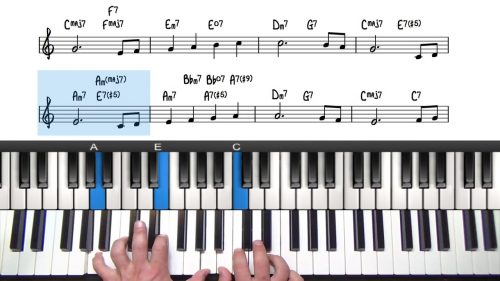Voicings For The Key Of C Major
In this lesson we explore voicing options for the diatonic chords of C Major. We cover all chord types: major, minor, dominant and -7b5 and a variety of voicing options are suggested for you to learn and internalise.
Voicings In Key Of C Major
This lesson is designed to show you potential voicing options that you can apply to jazz standards and common chord progressions.
We start with the major chords in the key of C Major (the I and IV chords) and explore major 7th voicings, 9th voicings, 69 voicings, rootless variations, and finally some interesting major 13 voicings.
We then explore common minor voicings for the ii, iii, and vi chords including the So What Voicing, the Herbie Hancock Voicing, and the Kenny Barron Voicing.
Dominant Alterations & Upper Structures
The V chord in every major key is a dominant 7th chord and we explore the different alterations and tensions that can be added. After working through the single alterations we apply the 4 common Upper Structure Triads.
Lesson Downloads
-
Major Voicing Options File Type: pdf
-
Minor Voicings Options File Type: pdf
-
Dominant & -7b5 Voicings Options File Type: pdf
Practice Tips
-
Learn the diatonic chord quality formula which is the same for all major keys. The formula is major/minor/minor/major/dominant/minor/-7b5.
-
Memorise the numeric construction of each voicing, ie. memorise each note of the voicing in terms of scale degrees.
- In the next lesson of this course we apply these voicings in context of common progressions such as 251s, 36251s, and 4736251s.






Hi Hayden,
Thanks for the course. With diligence, I’m finally getting a good grip on the chord progressions you teach. Can you recommend the most common scale patterns used in gospel music so that I can filter my practice to runs that are most relevant to that genre?
Hi Darren,
Thanks for the comment and I’m glad to hear on your progress!
Traditional Gospel music uses lots of pentatonic scales and to a lesser extent blues scales. Contemporary Gospel music incorporates the scales that we use in jazz piano. It’s hard to give you an exact scale to work on.
I would suggest to check out my Slow Blues For Beginners course here: pianogroove.com/blues-piano-lessons/slow-blues-piano-for-beginners/
Try the F major pentatonic scale over the F7 and C7, you can also incorporate the b3 which makes it the F major blues scale. For the Bb7, the F minor blues scale works very well. I have recorded lessons on exactly this topic which will be added to the slow blues course above shortly. They are currently being edited.
You might also like to check out these 2 lessons on the tune “Georgia” which is a gospel-style jazz standard and we explore the major/minor blues scale application mentioned above:
pianogroove.com/blues-piano-lessons/the-major-blues-scale/
pianogroove.com/blues-piano-lessons/georgia-on-my-mind-tutorial/
As mentioned it depends what type of Gospel you want to play, as the genre is quite diverse.
If you like, you can post a record here (from YouTube or Spotify) of the style of gospel improvisation that you like, and I can then give you some more specific recommendations.
In the interim check out the lessons referenced above.
Talk soon,
Hayden
Thanks Hayden,
I’m 63 years old and had almost given up on learning how to play keys like a professional. I’ve always had a gifted ear for music and was able to learn a handful of chords in a couple of keys on my own, but I fell way short of my goal. I’ve also followed a lot of musicians over the years who tried to teach me chords and scales, but I guess the building block approach that you use is what I needed. Thanks to you and your course, I’m finally “on my way”.
I only have an mp3 file to show you a sample of my goal in gospel music. So please see the attached file of a church organist adding scales/runs to Amazing Grace.